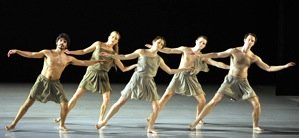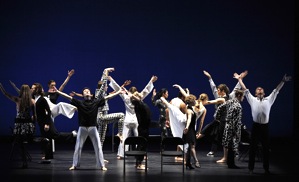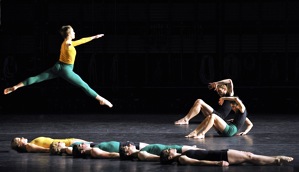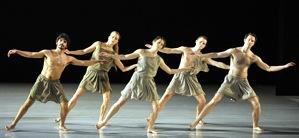Last week marked the first return of the Mark Morris Dance Group to UC Berkeley since Robert Cole’s retirement and Matías Tarnopolsky’s start as director of Cal Performances; Friday at Zellerbach Hall, it was good to see that not much has changed. The choreographer best known for illuminating complex scores and the dancers known for making virtuosity out of unaffected humanity were both doing just that — yet, in unexpected ways, Morris may have raised the bar.

Photos by Gene Schiavone
The program included one dance to silence, one in which the piano player was a ghostly absence, and a West Coast premiere taking on Satie’s Socrate, one of that composer’s oddest and most resolutely unmelodic works. The sum effect was of a soothing, purifying tonic. You walked out of the theater with a clear head and an open heart.
Socrate was performed in the piano and tenor arrangement, with beautiful clarity and calm by pianist Colin Fowler and tenor Michael Kelly. Morris clearly designed this treatment to give these musicians, and the music, equality of attention. This seemed wise, given the score’s ethos of dignified self-effacement, not to mention the amount of context for the audience to take in.
Above the stage, the text from Plato’s Phaedrus appeared in supertitles, and below, the calibrated simplicity of the dancing allowed watchers to lift their eyes to the words at regular intervals without missing something crucial in the choreography. The movement was made up mostly of repetitive skips, prances, and lunges that brought to mind some of the most affecting sections of Morris’ classic L’Allegro, Il Penseroso ed Il Moderato. Yet despite the surface plainness, a deeper formal scheme emerged, subtly reconciling opposites into a solemn spiritual and logical harmony.
In the first section, the “Portrait of Socrates,” all 15 dancers, clothed in Martin Pakledinaz’s beautiful silk tunics, flowed continuously from stage right to stage left, mostly in pairs, bending in strong, deep pliés. In the second section, “On the Banks of the Ilissus,” larger groupings washed continuously from stage left to stage right. And in the final section, the “Death of Socrates,” the dancers filled the stage from all entry points, collectively enacting Socrates’ suicide without becoming literally mimetic.
Indeed, just as the singer must play every part in Plato’s dialogue, every dancer played both Socrates and Phaedrus and even Crito at different moments. Most affectingly, all drank the poison in unison, spaced across the entire stage, and all died in unison, united in mortality. Along the way came poignant touches, like the motif in which pairs of dancers clasped raised hands, with one dancer raising her hand alone, a bittersweet nod toward the philosopher’s impending absence.
Revealing the Music of Movement

An absence was evident at the heart of Morris’ 2007 ballet Looky, too, as an empty bench sat before the piano while the keys delivered Kyle Gann’s Studies for Disklavier, powered by machine. Instead, Dallas McMurray sat center-stage as a gaggle of guests arrived, tiptoeing through a Les Sylphides-like setting of a Chopinesque waltz one moment, hoofing it Charleston-style through a jazz mashup the next.
The costumes, mixed and matched from older Morris works, had the effect of an elegant pajama party. Lauren Grant was terrific as the most drunken instigator of a sudden brawl. In the central section, a tour guide led visitors through as the dancers posed like sculptures, their spectators admiring and dismissing, until the statues turned to attack an unsuspecting Maile Okamura. Make of art what you will, Morris seemed to be cheekily saying. And in the opening Behemoth, we did. For in this early Morris piece, it is the sculptural, sculpturelike clarity of the bodily shapes that most commands attention. In their rapture over the choreographer’s formal response to music through spatial arrangement, people often forget this crucial element of his talent: his intuitive awareness of classical form in the body, and his ability to infuse every pose and step with human gesture.

When a dancer came through in straight jétes, you could understand the difference. In those series of leaps was a technical step — a recognizable jéte, nothing more or less — devoid of human content. Whereas in nearly every other step, from a chain of hip- and shoulder-swishing quarter turns to an up and down jump with heads looking down, arms pushing to the side as though the hands held a box, you felt an emotional, gestural logic behind the position.
It was good to see this foundational gift of Mark Morris laid bare again. Noah Vinson and Amber Star Merkens exuded a lovely, quiet control in their solos, while Julie Worden was distractingly beautiful in her proportions and her stateliness, as always. And in the unfolding order of their bodies’ shapes, you could see the music of movement itself.

